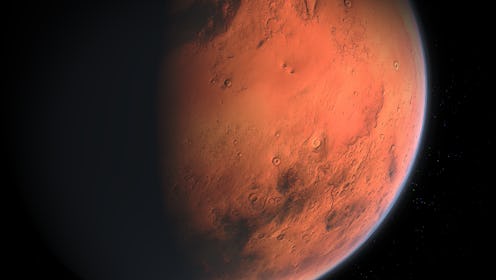Life
Will Humans Live On Mars One Day?

One of the foremost questions on any amateur astronomer's mind is whether humans can live on Mars within their lifetime. With the exponential advancements in technology made every year, colonizing Mars has gone from the stuff of science fiction to a possibility, albeit a distant one. During the Planetary Science Vision 2050 Workshop in late February, however, NASA revealed a fascinating new idea for making Mars habitable: launching a magnetic field between the planet and the Sun to protect it from high-energy solar particles.
Like many of its fellow projects discussed in D.C. last week, the shield is largely theoretical; the workshop was a self-described "long-range vision document with options, possibilities and a visionary future." In other words, it was an excuse for planetary science experts to get together and talk about scientific goals and hypothetical plans for achieving them — or at least starting on the path to achieving them — by 2050. But as you're about to find out, that doesn't make the talks any less fascinating.
According to Popular Mechanics, NASA's Planetary Science Division Director, Jim Green, gave a talk on March 1 called "A Future Mars Environment for Science and Exploration." His subject was enough to get any sci-fi geek excited: placing the aforementioned magnetic shield, called Mars L1, in an orbit around our neighboring planet.
Most scientists agree that billions of years ago, Mars used to have a global magnetic field, much like Earth, which protected its atmosphere from solar winds. At some point, however, that field disappeared, causing the atmosphere to slowly dissipate. On the now-vulnerable surface, things went from warm and wet to chilly and uninhabitable.
That's where the proposed shield comes in. Mars L1 would be composed of a giant dipole powerful enough to create a magnetic field. When placed in an orbit around the Red Planet, the shield should allow Mars' atmosphere to recover, safe within Mars L1's magnetotail. Simulations indicate that within years, the planet would be able to achieve half the atmospheric pressure of Earth. Without solar winds beating away at the planet, frozen carbon dioxide at the ice caps on either pole would begin to sublimate (change from a solid into a gas) and warm the equator. Ice caps would begin to melt, allowing part of Mars' ancient ocean to return.
"This is not terraforming as we may think about it, where we artificially change the climate, but we let nature do it," Green explained in his talk. The end result, however, is the same: a planet far more hospitable to human life than before.
Of course, this is all hypothetical, and Green noted at the end of his presentation that there's still plenty of work to be done even in regards to simulations. But it is a possibility for the future, and it shows just how quickly technology has advanced in the last century. Who knows how close to colonization we'll be 100 years from today?
To watch the talk for yourself, head over to the workshop's livestream — Green's presentation begins at 1:36.